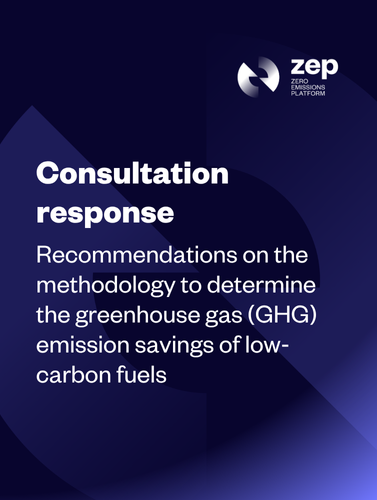Recommendations on the methodology to determine the GHG emission savings of low-carbon fuels
On 25 October 2024, the Zero Emissions Platform (ZEP) provided feedback on the draft methodology that determines the greenhouse gas (GHG) emission savings of low-carbon fuels.
Foreword
The primary objective of this Delegated Act (DA) must be to reduce GHG emissions, and thus, to ensure
that the fuels defined as “low-carbon” under the Renewable Energy Directive reflect this and align with the EU climate objectives.
To this end, ZEP stresses the need for a robust monitoring, reporting, and verification (MRV) framework, including for methane and hydrogen leakage, as mentioned in Article 9(5) of the recast EU Directive on gas and hydrogen markets. This DA must also establish clear and transparent system boundaries that are consistent with existing EU legislation and that prevent any potential confusion among all stakeholders.
In line with ZEP’s focus on industrial carbon management, the recommendations for this DA concern
CO2 capture, transport, and storage. ZEP also highlights lessons from existing commercial-scale
hydrogen projects using carbon capture and storage (CCS). More specifically, the focus of this response
is on the production of hydrogen and derivatives from processes involving steam methane reformation
(SMR) and auto-thermal reformation (ATR) of fossil fuels. Electricity-based production of hydrogen
from non-renewable sources, for example, nuclear or gas power, is not considered.
Summary of the ZEP’s key recommendations
- CCS technologies are proven and demonstrated on a commercial scale to significantly reduce emissions from the production of hydrogen through steam methane reformation (SMR) and autothermal reformation (ATR) processes.
- “Capture rate” is not a term legally defined and has various interpretations. A limit on total GHG emission intensity from the production of low-carbon fuels is preferable.
- Clarify which competent authority is to assess the natural release of CO2 from a geological source and what technical specifications must be met to qualify.
- Provide clarity with respect to geological storage of CO2 in jurisdictions outside the EEA and ensure consistency with the rules of the CCS Directive.
- Provide a level playing field on the MRV of the permanent storage of CO2 for carbon stored in a solid state, as is the case for CO2 stored in geological storage sites permitted under the CCS Directive
